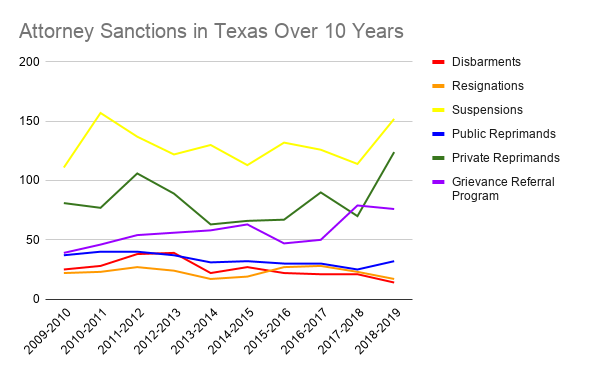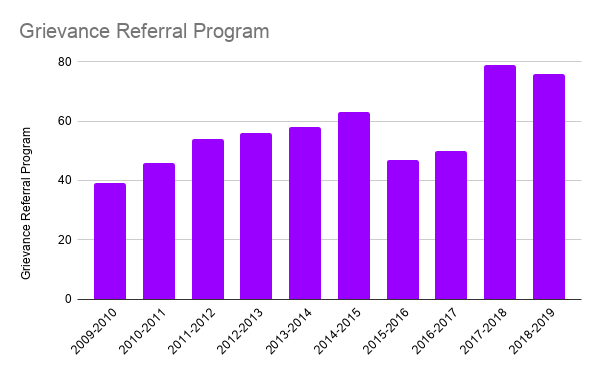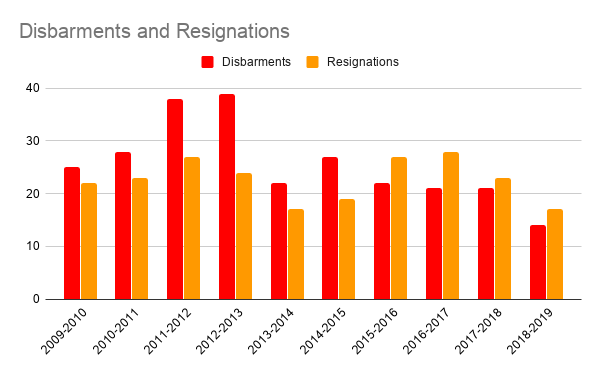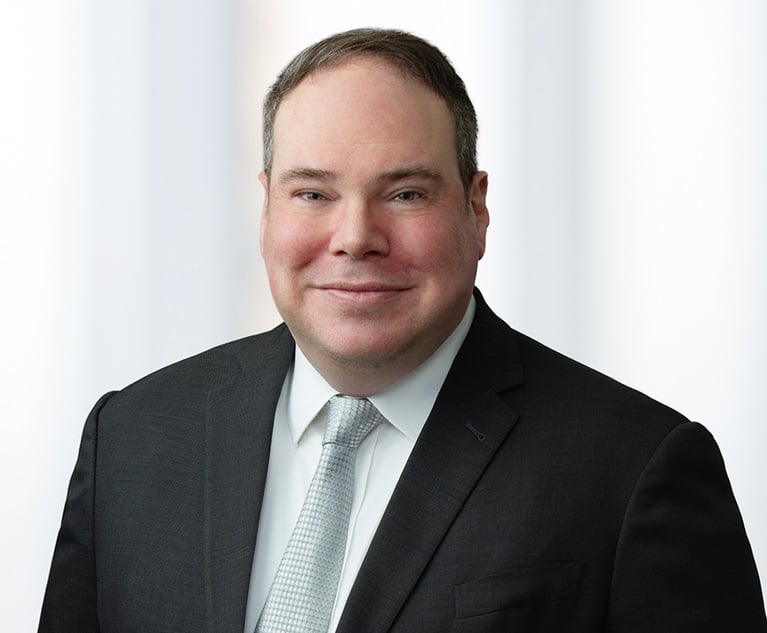Does Texas Have Enough Resources to Discipline Unethical Attorneys?
Austin legal ethics solo practitioner Jim McCormack, a former Texas Bar chief disciplinary counsel, said the state is "doing 2019 grievance work with a 1991 grievance system."
September 25, 2019 at 02:59 PM
6 minute read
 Photo: DNY59/iStockphoto.com
Photo: DNY59/iStockphoto.com
Attorney discipline statistics in Texas over the past 10 years show a grievance system that's surprisingly flat, despite steady increases in the state's lawyer population.
The number of complaints that ended in sanctions climbed and dipped over the decade with no clear trend but always stayed in the range 400 to 600 per year. The number of sanctions is lower because one attorney might have multiple complaints resolved with one sanction.
But over the past 10 years, the disciplinary counsel's office has doled out between 315 to 415 sanctions each year.
'1991 grievance system'
Austin legal ethics solo practitioner Jim McCormack, a former Texas Bar chief disciplinary counsel, said those total sanction numbers are on par with a review he did many years ago that looked at the grievance system spanning back to the 1990s.
"It looks like essentially we are doing 2019 grievance work with a 1991 grievance system," McCormack said. "I think it's worth asking the question: Do we have the right-sized grievance system?"
 Seana Willing, chief disciplinary counsel of the State Bar of Texas. Courtesy photo.
Seana Willing, chief disciplinary counsel of the State Bar of Texas. Courtesy photo.But Chief Disciplinary Counsel Seana Willing said she doesn't see anything alarming in the statistics.
Willing, who assumed her post in March, said she's unsure why the total number of sanctions has remained in the 300 to 400 range over the past decade. She hopes the reason is because her office has effectively created a deterrent against attorneys committing misconduct.
"If you are doing a good job, you wouldn't see more sanctions, more discipline," Willing said. "I feel like the [Chief Disciplinary Counsel's Office] and the Commission for Lawyer Discipline are doing an amazing job as far as their mission to protect the public. I think that's kind of the key that drives us to do what we do."
Claire Reynolds, spokeswoman of the chief disciplinary counsel's office, said that the total number of sanctions has probably remained constant because it's tracking the total number of grievances that people filed against lawyers.
Although the Lone Star State's attorney population grew by 19% from 86,500 in 2009 to 103,000 in 2018, the number of grievances that people filed against attorneys has remained fairly constant. In the past 10 years, grievances have ranged from 7,200 to 8,000 annually, or an average of 7,600.
The grievance funnel
The vast majority of grievances fizzle, either because they never alleged any attorney misconduct, or because disciplinary counsel found there wasn't just cause to believe that misconduct occurred.
Every year, between 70% to 80% of grievances are classified as inquiries and dismissed because they don't allege attorney misconduct. The percentage of grievances classified as complaints, which can proceed through the system, has ranged from 20% to 31% of total grievances filed over the past 10 years, for an average of 2,018 complaints per year.
Yet even when classified as complaints, these allegations often fail. Three-quarters of the complaints end with disciplinary counsel recommending dismissal, after not finding just cause that misconduct occurred.
 Source: State Bar of Texas. Graphic: Angela Morris/ALM. Note: Complaints dismissed through summary disposition numbers weren't immediately available for 2013-2014 and 2014-2015.
Source: State Bar of Texas. Graphic: Angela Morris/ALM. Note: Complaints dismissed through summary disposition numbers weren't immediately available for 2013-2014 and 2014-2015.Other times, a complaint doesn't bring a sanction because disciplinary counsel might lose a case before a grievance committee or in a district court, Reynolds noted.
"In theory, if a case has merit it should result in a sanction. And if it doesn't, it should result in a dismissal," she said.
Types of sanctions
Over the 10-year period, suspensions have been the most common form of sanction that attorneys face for misconduct.
Reynolds said that grievance committees can tailor suspensions to fit many situations. An attorney could be fully suspended, or suspended and then placed on probation. Suspensions can also be fully probated, she noted.
 Source: State Bar of Texas. Graphic: Angela Morris/ALM.
Source: State Bar of Texas. Graphic: Angela Morris/ALM.Private reprimands are the next most common sanction, followed by referrals to the grievance referral program. Both sanctions are only allowed for low-level offenses, and they're typically given to first-time offenders, Reynolds noted.
The grievance referral program, which involves sending lawyers through continuing legal education or counseling, shows one of the clearest trends over the past 10 years. The number of complaints resolved through the program has ticked up from 39 in the 2009 to 2010 bar year, to 76 in the 2018 to 2019 bar year.
 Source: State Bar of Texas. Graphic: Angela Morris/ALM.
Source: State Bar of Texas. Graphic: Angela Morris/ALM."It's proven to be a pretty positive experience for attorneys who have gone through it," Reynolds said, noting that their grievances are dismissed if they successfully complete the program.
The rarest forms of sanctions are also the most serious: disbarments and resignations in lieu of discipline, which have the same legal effect as disbarment. The number of disbarments has been trending down from a high of 39 in the 2012 to 2013 bar year, to a low of 14 in the 2018 to 2019 bar year.
Between 2009 to 2010 and 2014 to 2015 bar years, there were always higher numbers of disbarments versus resignations. This flipped in the 2015 to 2016 bar year: Over the past four years, there have been higher numbers of resignations than disbarments.
 Source: State Bar of Texas
Source: State Bar of TexasReynolds said it's hard to explain this trend without delving into the case-by-case facts of all of the disbarments and resignations. There's no formal initiative to encourage attorneys to choose to resign rather than proceeding in litigation to disbarment, she noted.
"I do think that as time has gone on, both us and the respondent attorneys, have seen that that's an easier way to resolve it for sure," she said. "It's less expensive. The more resignations you get, the more you can point to that as an example of a possible outcome for future cases."
Related story:
Attorney Ranks Rise, But Disciplinary Actions and Grievances Drop
This content has been archived. It is available through our partners, LexisNexis® and Bloomberg Law.
To view this content, please continue to their sites.
Not a Lexis Subscriber?
Subscribe Now
Not a Bloomberg Law Subscriber?
Subscribe Now
NOT FOR REPRINT
© 2025 ALM Global, LLC, All Rights Reserved. Request academic re-use from www.copyright.com. All other uses, submit a request to [email protected]. For more information visit Asset & Logo Licensing.
You Might Like
View All


Eversheds Sutherland Adds Hunton Andrews Energy Lawyer With Cross-Border Experience
3 minute read
Ex-Marathon General Counsel Takes Legal Reins of Another Energy Company
Trending Stories
- 1'It's Not Going to Be Pretty': PayPal, Capital One Face Novel Class Actions Over 'Poaching' Commissions Owed Influencers
- 211th Circuit Rejects Trump's Emergency Request as DOJ Prepares to Release Special Counsel's Final Report
- 3Supreme Court Takes Up Challenge to ACA Task Force
- 4'Tragedy of Unspeakable Proportions:' Could Edison, DWP, Face Lawsuits Over LA Wildfires?
- 5Meta Pulls Plug on DEI Programs
Who Got The Work
Michael G. Bongiorno, Andrew Scott Dulberg and Elizabeth E. Driscoll from Wilmer Cutler Pickering Hale and Dorr have stepped in to represent Symbotic Inc., an A.I.-enabled technology platform that focuses on increasing supply chain efficiency, and other defendants in a pending shareholder derivative lawsuit. The case, filed Oct. 2 in Massachusetts District Court by the Brown Law Firm on behalf of Stephen Austen, accuses certain officers and directors of misleading investors in regard to Symbotic's potential for margin growth by failing to disclose that the company was not equipped to timely deploy its systems or manage expenses through project delays. The case, assigned to U.S. District Judge Nathaniel M. Gorton, is 1:24-cv-12522, Austen v. Cohen et al.
Who Got The Work
Edmund Polubinski and Marie Killmond of Davis Polk & Wardwell have entered appearances for data platform software development company MongoDB and other defendants in a pending shareholder derivative lawsuit. The action, filed Oct. 7 in New York Southern District Court by the Brown Law Firm, accuses the company's directors and/or officers of falsely expressing confidence in the company’s restructuring of its sales incentive plan and downplaying the severity of decreases in its upfront commitments. The case is 1:24-cv-07594, Roy v. Ittycheria et al.
Who Got The Work
Amy O. Bruchs and Kurt F. Ellison of Michael Best & Friedrich have entered appearances for Epic Systems Corp. in a pending employment discrimination lawsuit. The suit was filed Sept. 7 in Wisconsin Western District Court by Levine Eisberner LLC and Siri & Glimstad on behalf of a project manager who claims that he was wrongfully terminated after applying for a religious exemption to the defendant's COVID-19 vaccine mandate. The case, assigned to U.S. Magistrate Judge Anita Marie Boor, is 3:24-cv-00630, Secker, Nathan v. Epic Systems Corporation.
Who Got The Work
David X. Sullivan, Thomas J. Finn and Gregory A. Hall from McCarter & English have entered appearances for Sunrun Installation Services in a pending civil rights lawsuit. The complaint was filed Sept. 4 in Connecticut District Court by attorney Robert M. Berke on behalf of former employee George Edward Steins, who was arrested and charged with employing an unregistered home improvement salesperson. The complaint alleges that had Sunrun informed the Connecticut Department of Consumer Protection that the plaintiff's employment had ended in 2017 and that he no longer held Sunrun's home improvement contractor license, he would not have been hit with charges, which were dismissed in May 2024. The case, assigned to U.S. District Judge Jeffrey A. Meyer, is 3:24-cv-01423, Steins v. Sunrun, Inc. et al.
Who Got The Work
Greenberg Traurig shareholder Joshua L. Raskin has entered an appearance for boohoo.com UK Ltd. in a pending patent infringement lawsuit. The suit, filed Sept. 3 in Texas Eastern District Court by Rozier Hardt McDonough on behalf of Alto Dynamics, asserts five patents related to an online shopping platform. The case, assigned to U.S. District Judge Rodney Gilstrap, is 2:24-cv-00719, Alto Dynamics, LLC v. boohoo.com UK Limited.
Featured Firms
Law Offices of Gary Martin Hays & Associates, P.C.
(470) 294-1674
Law Offices of Mark E. Salomone
(857) 444-6468
Smith & Hassler
(713) 739-1250






